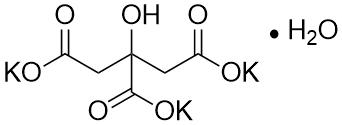Potassium citrate tribasic monohydrate is widely utilized in research focused on:
- Food Industry: It serves as a food additive, acting as a preservative and acidity regulator in products like soft drinks and processed foods, enhancing flavor and shelf life.
- Pharmaceuticals: This compound is used in the formulation of medications, particularly as an alkalizing agent to help manage urinary pH levels, which can aid in preventing kidney stones.
- Cosmetics: It is incorporated into cosmetic products for its buffering properties, helping to maintain pH balance in lotions and creams, thus improving skin compatibility.
- Biotechnology: In laboratory settings, it is used as a buffer in cell culture media, providing a stable environment for cell growth and experimentation.
- Agriculture: Potassium citrate is utilized as a chelating agent in fertilizers, enhancing nutrient availability to plants, which can lead to improved crop yields.
General Information
Properties
Safety and Regulations
Applications
Potassium citrate tribasic monohydrate is widely utilized in research focused on:
- Food Industry: It serves as a food additive, acting as a preservative and acidity regulator in products like soft drinks and processed foods, enhancing flavor and shelf life.
- Pharmaceuticals: This compound is used in the formulation of medications, particularly as an alkalizing agent to help manage urinary pH levels, which can aid in preventing kidney stones.
- Cosmetics: It is incorporated into cosmetic products for its buffering properties, helping to maintain pH balance in lotions and creams, thus improving skin compatibility.
- Biotechnology: In laboratory settings, it is used as a buffer in cell culture media, providing a stable environment for cell growth and experimentation.
- Agriculture: Potassium citrate is utilized as a chelating agent in fertilizers, enhancing nutrient availability to plants, which can lead to improved crop yields.
Documents
Safety Data Sheets (SDS)
The SDS provides comprehensive safety information on handling, storage, and disposal of the product.
Product Specification (PS)
The PS provides a comprehensive breakdown of the product’s properties, including chemical composition, physical state, purity, and storage requirements. It also details acceptable quality ranges and the product's intended applications.
Certificates of Analysis (COA)
Search for Certificates of Analysis (COA) by entering the products Lot Number. Lot and Batch Numbers can be found on a product’s label following the words ‘Lot’ or ‘Batch’.
*Catalog Number
*Lot Number
Certificates Of Origin (COO)
This COO confirms the country where the product was manufactured, and also details the materials and components used in it and whether it is derived from natural, synthetic, or other specific sources. This certificate may be required for customs, trade, and regulatory compliance.
*Catalog Number
*Lot Number
Safety Data Sheets (SDS)
The SDS provides comprehensive safety information on handling, storage, and disposal of the product.
DownloadProduct Specification (PS)
The PS provides a comprehensive breakdown of the product’s properties, including chemical composition, physical state, purity, and storage requirements. It also details acceptable quality ranges and the product's intended applications.
DownloadCertificates of Analysis (COA)
Search for Certificates of Analysis (COA) by entering the products Lot Number. Lot and Batch Numbers can be found on a product’s label following the words ‘Lot’ or ‘Batch’.
*Catalog Number
*Lot Number
Certificates Of Origin (COO)
This COO confirms the country where the product was manufactured, and also details the materials and components used in it and whether it is derived from natural, synthetic, or other specific sources. This certificate may be required for customs, trade, and regulatory compliance.

